Most orders for IN STOCK items placed by 12PM CST M-F ship SAME DAY. Orders for custom items and prints may take additional time to process.
So I have had a ton of requests over the years to give a tour of my home network. Honestly, I never gave the tour because I just didn’t think people would be that interested in what I had. Well I have had enough requests to get the idea that some of you really do want to see it. So in this article and video I will be giving that tour!
Some of you may not be aware, but not only are computers and technology my day job – but their are also a big part of my hobbyist adventures in addition to making things in workshop. And that means my home network is pretty advanced compared to the average home user. I am sure there will be some things in my setup that many of you disagree with. There’s always a different way to do something and there is always someone in the peanut gallery that thinks they can do it better (but of course they have not!). So enough of that, let’s get on with my home network tour!
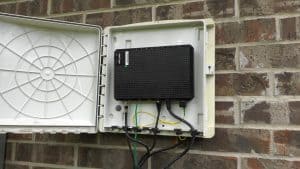
Some of you are going to assume that box on the outside of my house is my router. That would be an incorrect assumption. That box is called an Optical Network Terminal, or ONT for short. The ONT is owned and controlled by Frontier. The gigabit port on the outside of it is connected directly the WAN port on my firewall. Which means if you hack this device or plug into the cables on the outside of my home, you have no more access to my home network than you would over the internet.
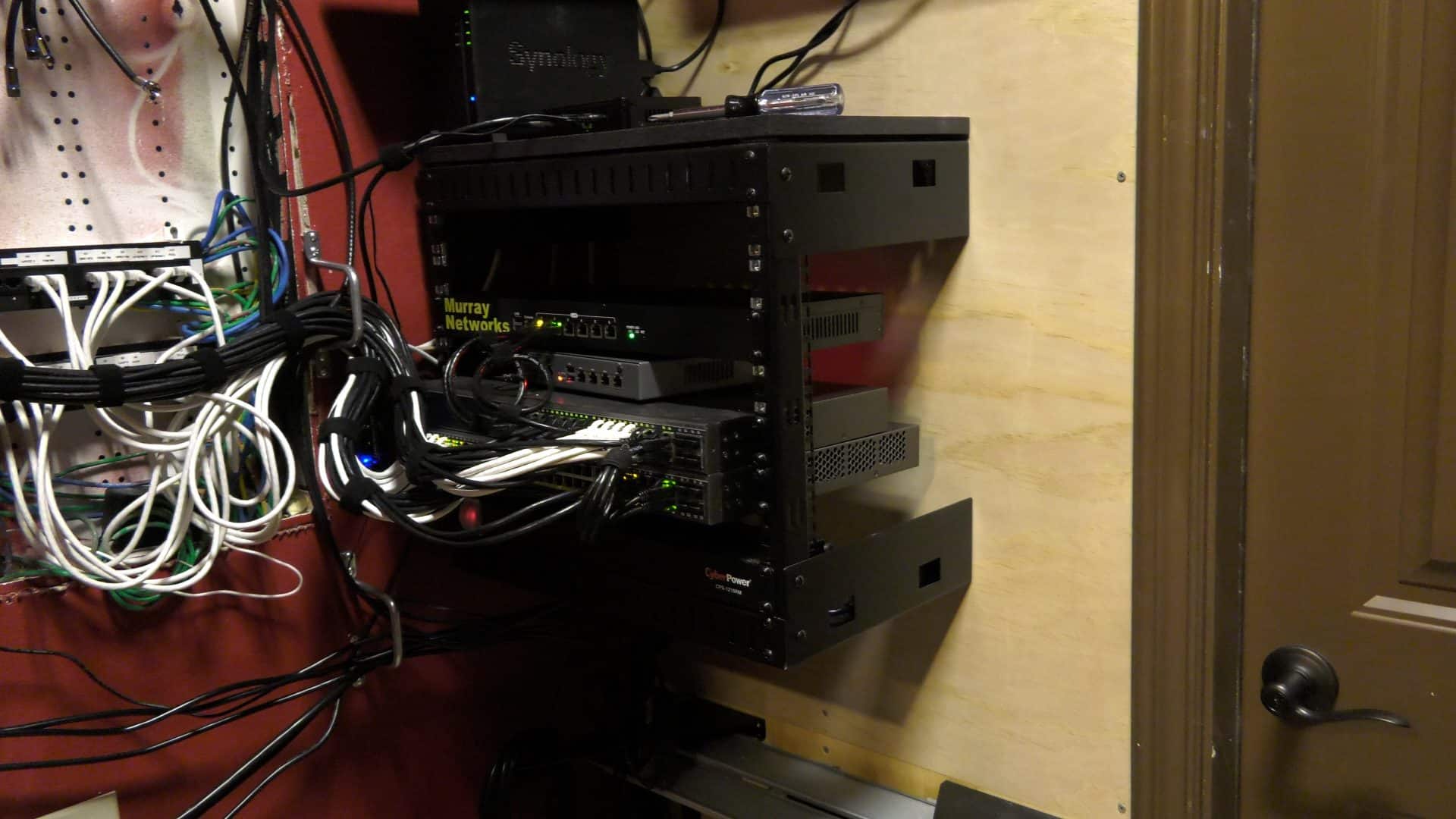
Over hear on the right is my main network gear. It’s just a little wall mount rack I got from Amazon. In fact, I will put a link in the description and on my website where to buy all of this gear if you are interested.
RELATED: Our Choice for the Best Home Network Racks
The firewall I am using is a six port unit that I personally imported from China. It’s something I am actually considering importing in bulk and selling on my website. It has six gigabit ports and I am currently running pfSense on it. You can’t get the one I bought yet, but this one is great for home use.
Below that is a 26 port managed switch that I used as my main distribution switch. Under that is a a 50 port managed switch that supports PoE or Power over Ethernet. This switch runs all of the cameras for my NVR which is a little Synology NVR216 that just sits on top of the rack. I have a whole video on installing this rack.
Down below that I have two Trip-Lite UPSes. These maintain power to everything during a power failure. With my load, they will run everything in my network closet for a little over an hour.
RELATED: Picking a Home UPS
I suspect many of you will critique my cable management. Go for it. I change things in here far too often to worry about that. Do I know how to do it better? Of course I do, its just not important in my setup. As I always tell the naysayers… “If you’re so much better than me, go make a YouTube video and show me how its done.”
Over to the left is where I keep my server equipment. I have a Synology RS2416+ running ten 3 terabyte Western Digital 7200 RPM drives, and fronted by two mirrored 250 gigabyte Samsung EVO 850 SSDs for caching. These cache drives make an incredible difference in performance since my servers are running ESXi and the operating systems live on the NAS.
Speaking of servers, these other two boxes are my servers. They are the 1U servers from a pervious video, but I moved them to 2U cases because I needed more PCIe slots for another project I was doing. In fact, I still have the 1U cases here in storage which I’ll probably build a lab box with at some point. These have servers VMs that run lots of different things in my home. I’m running Homeseer for home automation, PLEX for video serving and live-TV distribution, Observium for network monitoring, and several other things. And yes, I am legally licensed for all of this stuff.
Back over here on top of the network rack is one more device. This is an HD Homerun Extend. You plug an aerial antenna into it and then plug it into your ethernet network. Then using a number of different software packages, you can distribute broadcast TV around your home without the need to run antenna cables to all of your TVs. There are apps for almost any device, such as Apple TV, XBOX, or Smartphones. However, I simply have my PLEX media server distribute the video over the PLEX app. It’s simple and it works flawlessly.
Up here on above the servers is a Z-Net from Homeseer. This device broadcasts the Z-Wave protocol throughout my home which controls my Z-Wave switches and other devices for home automation. I really like this device because it allows me to run HomeSeer in virtual machine and move it between servers without the need to move a physical USB stick to the other physical box.
The last thing I’ll point out about my network closet is that it has a dedicated exhaust fan connected to the return side of my home air conditioning unit. This fan is always exhausting air from the room, even when the AC is not running. This keeps the room at comfortable temperature. I have a lot of info on this setup on my website at TheGeekPub.com.
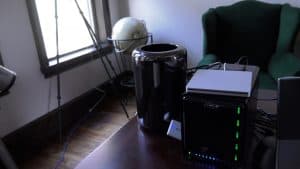
Behind my desk is a test PC, and a Gigabyte Brix running Chrome in full screen. This shows stats from Observium for my servers, networks, and Internet usage. You can see it also shows the temperature.
Over to the left of that I have the Pacade that I built in a previous video that is powered by a
Down here on the floor is my little lab rack. This was sent to me by Rosewill. I have plans for this little guy in an upcoming video. For now I am just running my lab switch in it which is powering a PoE camera that is watching our pool be built. Now that’s a project I can’t wait to be complete.
Of course, these aren’t really on my network, but this is where I am starting the buildout of my 8-Bit computer museum. If someone wants to send me an Altair 8800, feel free!
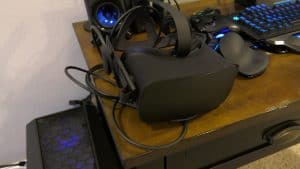
In the middle of the room is our Gaming rig. I built this rig with my son a year or so ago. It’s running an ASUS Z170 pro-gaming motherboard, an Intel Skylake i7-6700K processor, 16 gigabytes of RAM, and a GeForce GTX-1080 video card. Some of you have probably already noticed that we’re also rocking an Oculus Rift. I am huge fan of virtual reality. For those of you who think its a fad like 3D TV was, I challenge you to try the Oculus or the HTC Vive. That stuff that you put your smartphone in isn’t even close to this experience.
Lastly, this is where have our console gaming area setup. We only have the XBOX ONE running right now, but at some point I do hope to add the next-generation PlayStation to the mix. This is the XBOX ONE Day One Edition.
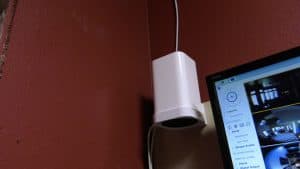
I also love these awesome Airport Extreme wall mounts.
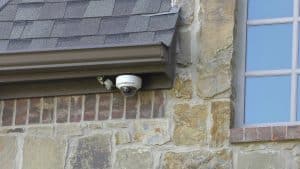
Lastly, in addition to these regular alarm pads on the walls, we have electronic keypads on the exterior doors. These keypads interface with the home automation system and alarm for granting access to the home. This allows us to do some really neat stuff like restrict a maids access to a certain day and set of hours. This helps prevent a burglary by service company personnel when we are out of town or on a day they wouldn’t normally be here. Also, check out my write-up on the best smart locks!
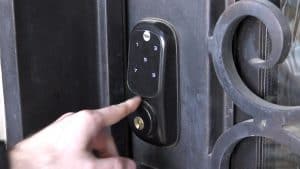
For controlling my theater room and living room devices I used Harmony Hubs. These devices are so simple to setup and make it a breeze to connect to Alexa, Siri, and HomeSeer. Just saying “Alexa, Turn on Movie Night” and all of the gear turns on, the lights dim, etc. Want to change the volume? Just ask Alexa or Siri. Want to change the channel or play a certain song? Just ask Alexa or Siri.
I hope you enjoyed this tour of my home network! It’s been highly requested for over a year now! The first time someone asked for tour of my home network I thought they were insane, but apparently people really did want one. I am sure there will be a lot of questions on this tour, so as they pop along in the comments I will update this FAQ below:
Q. Do you wish you had done anything different?
A. Not really. I guess the one thing I wish I had done was to make my network closet about two feet wider so I could fit a larger rack. I also don’t like that it is connected to the theater room because it can get noisy sometimes. I like my theater room to be very quiet. Honestly the noisiest item in the closet is the 50 port PoE switch. There is a fan mod you can do to shut them up. Maybe I might do that.
Q. Why aren’t the wires in your closet a little neater?
A. Because I am constantly changing stuff, testing something new, or trying out a different configuration. It’s a hobby and I like to tinker. At first, I kept it immaculate. But it just got far too annoying to keep it that way.
Q. Are you related to The 8-bit Guy?
A. I am offended that you think so, but check the about me section for the answer to this one.
Q. Where can I get that awesome firewall you showed off?
A. You can’t currently. I imported several of them from China for myself and some friends. I might buy a few more to sell on my website at some point. I’ll update this if I do.
Q. Where do you live?
A. The Dallas/Fort Worth area. I won’t give more specifics.
Q. Are you licensed for ESXi? That’s expensive! You’re a pirate!
A. ESXi first of all is free. However, I am licensed for the add-ons. You can get a VMUG subscription for home use, testing, and development work. It costs about $150 a year.
Q. Why not go with a Dell PowerEdge rather than those home brew servers?
A. Because part of my hobby is building and tinkering. But most importantly because those PowerEdge boxes are far too noisy and power hungry for my liking.
If you like our content maybe consider upgrading to Premium. You’ll get access to
10 Responses
hey, loved the video and the article. got some great ideas for my home network.
my main question is how you run the network to your office and game room? do you have ethernet wiring throughout the house? or are you using some sort of wifi bridge?
Yes. There is hardwired Ethernet in every room.
Hi mike, luckily YouTube suggested your video, they finally did a good thing!
Where did you get your actual router hardware?
Is it a secret or just difficult?
At my Ham-radio club and at home I’d like to use affordable low energy hardware instead of the current small servers for pfsense, but there will be quite some traffic in the months to come.
Hope to hear from you! Thnx for the tour, inspiring!
Thegeekpub at uberia dot NL
Mike, Love the videos!! I am currently looking to setup a central access point in my house for a server/media room only problem is the house is not wired for ethernet so I have to hire someone to come install them in every room. Would you suggest going comepletly wireless? If I do go hardwired Cat 6 or Cat7? Where would you suggest the best place for a access point be? Any advice would be great. Keep putting videos out, I am really enjoying them 🙂
Thanks,
Travis
Cat 5e should be plenty for everything, unless you plan on running 10Gb at some point. Cat 7 is incredibly expensive.
Can I ask you, where did you get your actual router hardware?
I’d really like to know.
Thanks, Lennart
Nice Post! and actually now knowing Startech is useful for home racks is worthy enough advice, thanks! Glad to see more people using HDHomerun boxes…I have Prime and Connect. Are you thinking of switching out to maybe ubnt gear for wireless if/when the airports meet their lifetime?
I’ll make that call when then time comes based on what tech is available then.
I really liked the video! I’m in the process of having my house built and I’m planning on building out my home network somewhat similar to yours. Although I’m looking at integrating my cameras and a few other things through Nest. I’m a network/storage engineer but know very little about electrical work and where I should cable my cat6a and RJ6. Could you offer some advise and look at my network diagram and cabling by chance? Seems like you really know what you’re doing there.
4.5